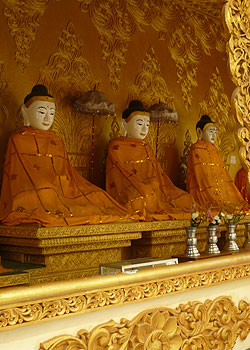In the lower Myanmar delta area which we call the Ayeyarwady Division there is a coastal town by the name of Pathein. In the colonial days the British called it Bassein. It lies on the Gnawun river bank and is 75 miles away from the sea. The distance between Pathein (Bassein) and Yangon is 191 miles (by rail). The precise location of it is 16.45 N and 94.48 E. Regarding this Bassein of the bygone era Hobson-Jobson noted.
Centuries ago Pathein was known as Cosmin. Ralph Fitch. the first recorded British traveller who visited Myanmar between 1586 and 1588 called it Cosmin. Some authorities argued that this word Cosmin was a corruption of two Mon words kaw and thamein. The word kaw signifies an island and thamein a prince.


Pieced together it becomes prince island and the Myanmar call it minthakyun. To quote Hobson-Jobson again Cosmin is given by many travellers in the 16th and 17th centuries to a port on the western side of the Ayeyarwaddy delta which must have been near Bassein if not identical with it.
In the mid-sixteenth century Bassein. like Dagon (later Yangon) was an insignificant port. These two ports could not measure up to Thanlyin (Cirion or Syriam). Dalla. Mottama (Martaban) and Bago (Pegu) which were noteworthy ports in those days. At that time Bassein was just a minor port and hardly conducted any important overseas trade transactions.
The origin of the Indian town of Bassein has much to do with the growth of Portuguese imperialism. The starting point was 1498. the year Vasco da Gama discovered the sea route to the east. From then on Portuguese ships began to enter the Pacific Ocean through the Straits of Malacca. Within a short time Portugal became an imperial power. This was the beginning of the encounter between Europe and Asia.
Pathein Today Pathein is the capital of the deltaic region. This port of call is reached by road. or by double deckers through the complex Ayeyarwady river deltaic region. The landscapes are all full of rice producers with crops such as sesames. groundnuts. jute. maize. pulses. tobacco. chilies. etc. Parasol production is synonymous with Pathein.
Pathein is still an important port of call for ferryboats carrying passengers or cargo plying between Yangon and the northern and eastern parts of the Myanmar. So it has a rather busy harbor area. which is fronted by a crescent of shop houses and go-downs. Rice from the delta region continues to be exported through the port of Pathein.
Some 300.000 people live in Pathein. which was established in 1852 as a garrison town by the British. Although the majority are ethnic Bamars (formerly Burmans) and mainly Buddhist. there is a significant number of Kayin (formerly Karen) who are either Catholics or members of the Karen Baptist Church. These are mainly lowland farming Karen who were encouraged by the British to move form Karen state in eastern Myanmar to help settle the delta region. which was in need of rice farmers.
TRAVEL TIPS
- Accessible by car. Only about 3 hours drive from Yangon.
- There are also express buses carrying passengers everyday.
AROUND PATHEIN
Mawtinson Pagoda
It is the most famous pagoda in Pathein. If you follow the Pathein River till it empties into the Adman Sea you’ll reach Cape Mawtin (Mawtinson). site of a well-known festival during the lunar month of Tabodwe (February. March). On the seaside of the Cape is a sandy beach and the revered Pagoda Maw Tin Son. It is very surprising to note that the pagoda is water-logged all the year round except in the days of the annual festival. The seawater is out well beyond the pagoda during the festival and lots of stalls dealing with all sorts of local products. seafood. ornaments. made of seashells. and lodging houses. built of bamboo for the revellers mushroom on the beach. Once the festival is over. the water is up and covered the beach. It seems that the pagoda is located on the sea.
From Pathein. there are roads to the popular beaches of Myanmar. Chaung Thar Beach and Ngwe Saung Beach. From Pathein. it will take only about 3 hours drive through the mountains and to the beautiful beaches.
